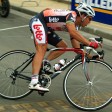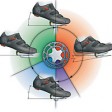 There is much confusion on whether cyclists and triathletes should use strength and conditioning (S&C) as part of their cycling training. The traditional thinking has been that spending time on a bike will make a more accomplished rider and will improve an individuals ability. Whilst I can’t disagree with this thinking, there are caveats to it. As PT’s and trainers we can help cyclists become better riders through strength training. Periodising this into an appropriate stage of training can help improve a cyclists endurance, speed and power.
There is much confusion on whether cyclists and triathletes should use strength and conditioning (S&C) as part of their cycling training. The traditional thinking has been that spending time on a bike will make a more accomplished rider and will improve an individuals ability. Whilst I can’t disagree with this thinking, there are caveats to it. As PT’s and trainers we can help cyclists become better riders through strength training. Periodising this into an appropriate stage of training can help improve a cyclists endurance, speed and power.
By spending all our training time on the bike we will become a better cyclist by being more in tune with the bike, being more comfortable in a cycling position and hopefully (with correct guidance) create a more efficient and functional pedal stroke, whilst also increasing our cardiovascular fitness.
This said, I personally believe that S&C has a vital part to play in making you a better cyclist, whether it be for triathlon or for cycling alone. What we have to do is understand what we mean by S&C and that it doesn’t solely mean strength training and lifting or pushing heavy weights, it also takes into account core stability and flexibility.
Flexibility improves posture and increases the range of motion of the joints, so we don’t have any sticking points within the pedal stroke, It also is a great injury preventer.
GB cycling S&C coach has been quoted as saying “it’s like the difference between a door that has oiled hinges and one that grinds to and fro. The more freely you move, the more power you can put out.”
Core stability is vital in cyclists due to the position we spend the majority of the time in. A weak core will lead to postural problems and thus make this riding position very uncomfortable, especially the more aerodynamic we look to be. A strong core will not only allow us to be comfortable and aerodynamic but also allow a greater transfer of power through the legs.
Later, we will talk about specific areas that need flexibility attention.
More and more top athletes are making S&C a vital part of their training. Below I will talk about what will make up this part of their training:
Strength training:
 Calves – Strong calves will contribute to a more powerful pedal stroke as illustrated by the diagram below.
Calves – Strong calves will contribute to a more powerful pedal stroke as illustrated by the diagram below.
Exercises: Calf raises
Hamstrings and Glutes – the forgotten muscle groups, the hamstrings and glutes are vital for an efficient pedal stroke, especially when clipped into pedals. If there is too much of a muscle imbalance between hamstrings/glutes and quadriceps, it will create a very uneven pedal stroke and put a huge emphasis on the quads. Strong hamstrings will allow you to pull up and over on the pedal stroke and not have to rely on the quadriceps.
Exercises: Lunges, Swiss ball hamstring curls, Romanian deadlifts, Glute-ham raises.
Quadriceps – You only need to take a look at Chris Hoy to see that strong quadriceps play a ‘big’ part in cycling! They often provide the power, this is not only important in sprint events on the track but also in endurance riding in the tour events.
Exercises: Squats (plus all the varieties of squats), Deadlifts, Leg extensions.
Upper body – Although, cycling is a predominantly lower body sport, upper body training will give you balance throughout the body and also help with your posture.
Exercises: Lat Pull down, Bent-over row, Chest press.
 As you can see from this diagram, a huge number of lower body muscles play a part in the pedal stroke and that to have an efficient stroke you need to be strong in all the right areas.
As you can see from this diagram, a huge number of lower body muscles play a part in the pedal stroke and that to have an efficient stroke you need to be strong in all the right areas.
We talked about the importance of flexibility and core stability and now we need to discuss what we need to do in these disciplines.
Flexibility:
Hamstrings: These become tight because of the position we adopt when cycling. Tight hamstrings are also the number one cause for lower back pain in the general population so need particular attention. They are also needed when we run, so for triathletes, flexible and functional hamstrings will not only improve cycling but also the running element.
Hip flexors: As human beings, we are designed to be in an upright position, due to various reasons, we spend most of our time in a seated position and so exercising in an even more bent over position like we do when we cycle causes our hip flexors to be very tight
Gluteals: Unlike the hip flexors, the glutes are in an open position when we are in a riding position, however, as you can see from the diagram above they are used for a large portion of the pedal stroke (hopefully), thus the more you ride, the tighter they will become. This becomes more important for triathletes as like the hamstrings the glutes play a major role in running.
Core stability:
Plank: The plank makes the whole core work in an isometric contraction and thus makes us stronger in a fixed position, like we are when we ride. To make this more functional to cycling we can use a swiss ball and perform knee tucks as if we are pedalling.
Superman: This puts our body into a position of instability and so we learn to contract or brace the core in order for us to keep a strong rigid position.
Back extensions: The more time we spend on the bike, the more time the back is in a tight flexed position. Thus we want to be able to move dynamically in the opposite direction, so these muscles don’t switch off and become weak.
V-sits: These work both the upper and lower abdominals and give us the ‘six-pack’ for pure aesthetic reasons!!!
Hopefully this will go some way to helping your clients make their minds up about what they should be doing to make themselves a better cyclist.
Share this article with your cycling clients and invite them to book some personal training for your cycling with you
Why not consider training as a personal trainer with our new diploma long and short course options.
